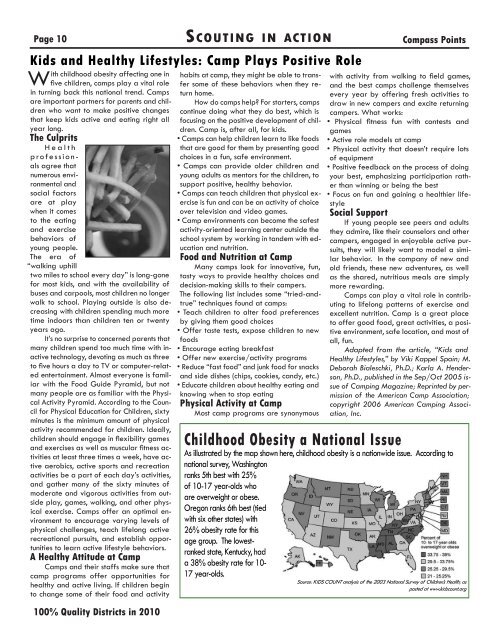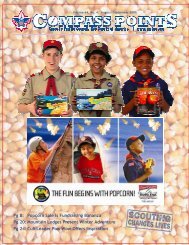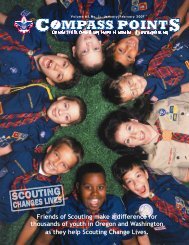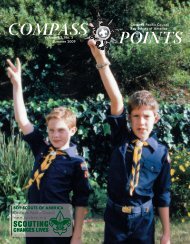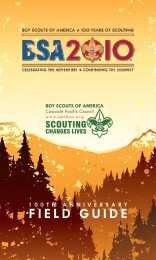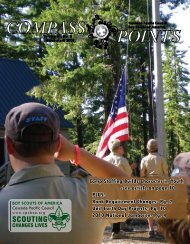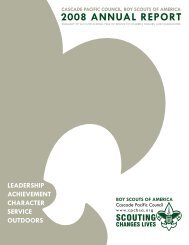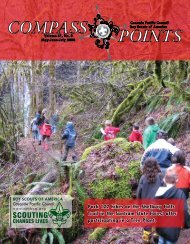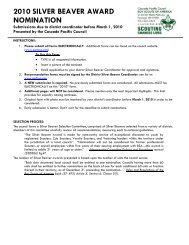7MB (PDF) - the Cascade Pacific Council Home Page!
7MB (PDF) - the Cascade Pacific Council Home Page!
7MB (PDF) - the Cascade Pacific Council Home Page!
You also want an ePaper? Increase the reach of your titles
YUMPU automatically turns print PDFs into web optimized ePapers that Google loves.
<strong>Page</strong> 10<br />
100% Quality Districts in 2010<br />
Sco u t i n g in a c t i o n<br />
Kids and Healthy Lifestyles: Camp Plays Positive Role<br />
With childhood obesity affecting one in<br />
five children, camps play a vital role<br />
in turning back this national trend. Camps<br />
are important partners for parents and children<br />
who want to make positive changes<br />
that keep kids active and eating right all<br />
year long.<br />
The Culprits<br />
H e a l t h<br />
professionals<br />
agree that<br />
numerous environmental<br />
and<br />
social factors<br />
are at play<br />
when it comes<br />
to <strong>the</strong> eating<br />
and exercise<br />
behaviors of<br />
young people.<br />
The era of<br />
“walking uphill<br />
two miles to school every day” is long-gone<br />
for most kids, and with <strong>the</strong> availability of<br />
buses and carpools, most children no longer<br />
walk to school. Playing outside is also decreasing<br />
with children spending much more<br />
time indoors than children ten or twenty<br />
years ago.<br />
It’s no surprise to concerned parents that<br />
many children spend too much time with inactive<br />
technology, devoting as much as three<br />
to five hours a day to TV or computer-related<br />
entertainment. Almost everyone is familiar<br />
with <strong>the</strong> Food Guide Pyramid, but not<br />
many people are as familiar with <strong>the</strong> Physical<br />
Activity Pyramid. According to <strong>the</strong> <strong>Council</strong><br />
for Physical Education for Children, sixty<br />
minutes is <strong>the</strong> minimum amount of physical<br />
activity recommended for children. Ideally,<br />
children should engage in flexibility games<br />
and exercises as well as muscular fitness activities<br />
at least three times a week, have active<br />
aerobics, active sports and recreation<br />
activities be a part of each day’s activities,<br />
and ga<strong>the</strong>r many of <strong>the</strong> sixty minutes of<br />
moderate and vigorous activities from outside<br />
play, games, walking, and o<strong>the</strong>r physical<br />
exercise. Camps offer an optimal environment<br />
to encourage varying levels of<br />
physical challenges, teach lifelong active<br />
recreational pursuits, and establish opportunities<br />
to learn active lifestyle behaviors.<br />
A Healthy Attitude at Camp<br />
Camps and <strong>the</strong>ir staffs make sure that<br />
camp programs offer opportunities for<br />
healthy and active living. If children begin<br />
to change some of <strong>the</strong>ir food and activity<br />
habits at camp, <strong>the</strong>y might be able to transfer<br />
some of <strong>the</strong>se behaviors when <strong>the</strong>y return<br />
home.<br />
How do camps help? For starters, camps<br />
continue doing what <strong>the</strong>y do best, which is<br />
focusing on <strong>the</strong> positive development of children.<br />
Camp is, after all, for kids.<br />
• Camps can help children learn to like foods<br />
that are good for <strong>the</strong>m by presenting good<br />
choices in a fun, safe environment.<br />
• Camps can provide older children and<br />
young adults as mentors for <strong>the</strong> children, to<br />
support positive, healthy behavior.<br />
• Camps can teach children that physical exercise<br />
is fun and can be an activity of choice<br />
over television and video games.<br />
• Camp environments can become <strong>the</strong> safest<br />
activity-oriented learning center outside <strong>the</strong><br />
school system by working in tandem with education<br />
and nutrition.<br />
Food and Nutrition at Camp<br />
Many camps look for innovative, fun,<br />
tasty ways to provide healthy choices and<br />
decision-making skills to <strong>the</strong>ir campers.<br />
The following list includes some “tried-andtrue”<br />
techniques found at camps:<br />
• Teach children to alter food preferences<br />
by giving <strong>the</strong>m good choices<br />
• Offer taste tests, expose children to new<br />
foods<br />
• Encourage eating breakfast<br />
• Offer new exercise/activity programs<br />
• Reduce “fast food” and junk food for snacks<br />
and side dishes (chips, cookies, candy, etc.)<br />
• Educate children about healthy eating and<br />
knowing when to stop eating<br />
Physical Activity at Camp<br />
Most camp programs are synonymous<br />
Compass Points<br />
with activity from walking to field games,<br />
and <strong>the</strong> best camps challenge <strong>the</strong>mselves<br />
every year by offering fresh activities to<br />
draw in new campers and excite returning<br />
campers. What works:<br />
• Physical fitness fun with contests and<br />
games<br />
• Active role models at camp<br />
• Physical activity that doesn’t require lots<br />
of equipment<br />
• Positive feedback on <strong>the</strong> process of doing<br />
your best, emphasizing participation ra<strong>the</strong>r<br />
than winning or being <strong>the</strong> best<br />
• Focus on fun and gaining a healthier lifestyle<br />
Social Support<br />
If young people see peers and adults<br />
<strong>the</strong>y admire, like <strong>the</strong>ir counselors and o<strong>the</strong>r<br />
campers, engaged in enjoyable active pursuits,<br />
<strong>the</strong>y will likely want to model a similar<br />
behavior. In <strong>the</strong> company of new and<br />
old friends, <strong>the</strong>se new adventures, as well<br />
as <strong>the</strong> shared, nutritious meals are simply<br />
more rewarding.<br />
Camps can play a vital role in contributing<br />
to lifelong patterns of exercise and<br />
excellent nutrition. Camp is a great place<br />
to offer good food, great activities, a positive<br />
environment, safe location, and most of<br />
all, fun.<br />
Adapted from <strong>the</strong> article, “Kids and<br />
Healthy Lifestyles,” by Viki Kappel Spain; M.<br />
Deborah Bialeschki, Ph.D.; Karla A. Henderson,<br />
Ph.D., published in <strong>the</strong> Sep/Oct 2005 issue<br />
of Camping Magazine; Reprinted by permission<br />
of <strong>the</strong> American Camp Association;<br />
copyright 2006 American Camping Association,<br />
Inc.<br />
Childhood Obesity a National Issue<br />
As illustrated by <strong>the</strong> map shown here, childhood obesity is a nationwide issue. According to<br />
national survey, Washington<br />
ranks 5th best with 25%<br />
of 10-17 year-olds who<br />
are overweight or obese.<br />
Oregon ranks 6th best (tied<br />
with six o<strong>the</strong>r states) with<br />
26% obesity rate for this<br />
age group. The lowestranked<br />
state, Kentucky, had<br />
a 38% obesity rate for 10-<br />
17 year-olds.<br />
Source: KIDS COUNT analysis of <strong>the</strong> 2003 National Survey of Children’s Health; as<br />
posted at www.kidscount.org


